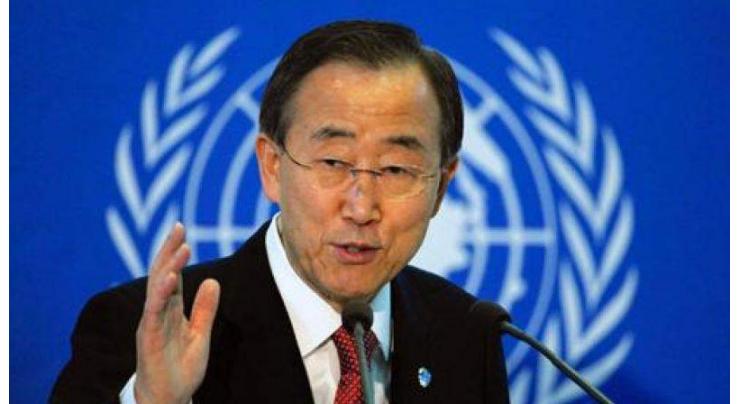
Property, Troops, Mines Divide Cyprus Since 1974
Sumaira FH Published November 05, 2016 | 08:20 AM

NICOSIA, Nov 5, (APP - UrduPoint / Pakistan Point News - 05th Nov, 2016 ) - For more than four decades, talks for a reunified Cyprus, back on the table since May last year, have failed to reach a power-sharing formula for Greek and Turkish Cypriots.
UN chief Ban Ki-moon will open negotiations in Switzerland on Monday between rival Cypriot leaders in an attempt to overcome issues inherited from the 1974 invasion: lost homes, Turkish soldiers and landmines on the Green Line dividing the island.
Property ======== During the Turkish invasion, some 200,000 people fled in a population exchange, Greek Cypriots to the south and Turkish Cypriots to the north, abandoning their belongings, homes and land.
In the north, many Greek Cypriot properties are now occupied by Turkish Cypriots, Turkish settlers and even foreigners including Britons after controversial purchases. In the south, the government has assigned some former Turkish Cypriot homes to Greek Cypriot refugees.
The island's main Larnaca airport and refugee housing were built on land belonging to Turkish Cypriots. Greek Cypriots who have lost hope of retrieving their property in the north are increasingly turning to a Turkish commission to compensate them.
But this is discouraged by the Greek Cypriot authorities who view it as rightful owners giving in and selling their property cheap. Missing persons =============== In 2006, a bicommunal committee supported by the United Nations started to excavate the remains of people who went missing in Cyprus during 1963-1964 inter-communal violence and the 1974 invasion.
Of the 2,001 persons officially missing, about half have been found and more than 600 returned to their families. But hundreds of possible graves remain untouched. In a breakthrough last year, Ankara agreed to allow access to possible mass graves in military zones in northern Cyprus.
Soldiers and settlers ===================== The Republic of Cyprus estimates that more than 160,000 settlers from Turkey's poorest regions live on the island.
Official Turkish Cypriot figures show that of the 286,000 inhabitants in the north, 118,000 (40 percent) are Turkish expats, including 38,000 (13 percent) granted Turkish Cypriot "nationality".
But Ankara has also deployed some 30,000 Turkish troops on the island, according to Turkish Cypriot authorities. Even some Turkish Cypriots object to their presence, which is seen as a major obstacle to reunification.
Landmines ========= The United Nations in 2010 said it had removed landmines in almost all of the island's buffer zone. But a lack of detailed maps showing the zones where landmines were planted before 1974 has prevented the UN from clearing thousands of landmines in the rest of the island.
In 2015, the Greek Cypriots handed over a map of 28 minefields that UN experts are examining. Ghost town ========== In 1974, when Greek Cypriots fled the seaside resort of Varosha, Turkey's army cordoned off its affluent homes and hotels with barbed wire.
The island's Saint-Tropez became a ghost town, its memory haunting some 40,000 former residents. In retaliation for the Turkish occupation, the Republic of Cyprus pressed for an international embargo on the self-proclaimed Turkish Republic of Northern Cyprus, recognised only by Ankara.
Direct international trade with northern Cyprus, ships docking in Famagusta port and planes landing at Ercan airport are banned. Passengers and goods instead have to transit via Turkey, which hampers tourism and economic activity in the north.
Both sides also disagree over the town of Morphou, on the island's northern coast, with Greek Cypriot President Nicos Anastasiades warning last month that there could be no deal without a full return of the territory.
Related Topics
Recent Stories

DC calls for intensive anti-polio drive in ICT

Arsenal paid for 'big mistake' in Bayern defeat: Arteta

Progress of development schemes reviewed

Pak Italian Modern Centre (PIBC) Executive Director, Dr Naveed Akhtar resigns

Bazm-e-Rooh Rihan to holds reception in hounour of Naseer Mirza

Four govt officials killed in DI Khan firing incident

Local admin imposes section 144 in Abbottabad

Ukraine calls for energy savings amid Russian strikes

Matthews leads West Indies women to convincing victory over Pakistan in series o ..

Israel bombs Gaza as Middle East tense after Iranian attack

Turkish foreign minister to hold talks with Dutch counterpart in Netherlands

Paris says 'no grounds' for Burkina Faso to expel French diplomats
More Stories From World
-

Ukraine calls for energy savings amid Russian strikes
20 minutes ago -

Israel bombs Gaza as Middle East tense after Iranian attack
20 minutes ago -

Turkish foreign minister to hold talks with Dutch counterpart in Netherlands
20 minutes ago -

Paris says 'no grounds' for Burkina Faso to expel French diplomats
20 minutes ago -

Human cases of bird flu 'an enormous concern': WHO
25 minutes ago -
Deemah highlights Pakistan's digital potential at ICTN Asia Conference
1 hour ago
-
German far-right firebrand in court for using Nazi slogan
2 hours ago -
Inter seeking Milan derby Serie A title delight
2 hours ago -
Football: Italian Serie A table
2 hours ago -
Germany arrests two over military base attack plot for Russia
2 hours ago -
Ukraine says hit Russian airfield in annexed Crimea
2 hours ago -
China's Wang meets Indonesia's Jokowi, president-elect Prabowo
3 hours ago




